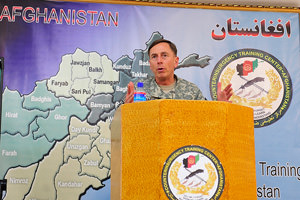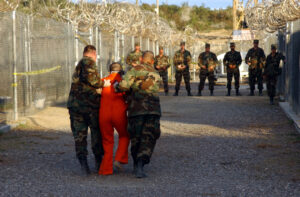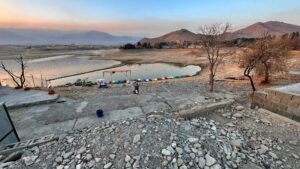Shifting War Strategy Smacks of Desperation
The first decision made by Gen. David Petraeus as commandant of international forces in Afghanistan has been to abandon the policy he himself drafted in order to win the war and rebuild Afghan stability and government.
The first decision made by Gen. David Petraeus, the successor to Gen. Stanley McChrystal as commandant of international forces in Afghanistan, has been to abandon the policy he himself drafted in order to win the war and rebuild Afghan stability and government.
He has done so because it has not worked. It has failed to “clear” Taliban guerrilla forces from the areas taken by international security troops. The guerrillas leave when the foreign troops launch an offensive. They inflict casualties on the invaders as they go, leaving behind mines, roadside bombs, booby-trapped roads and houses, intending to harm apprehensive peasants and townspeople as well, who know that the Taliban will eventually return, and that those Afghans who have collaborated with the foreigners will be punished or killed.
The prospect of giving Afghanistan a functioning and competent democratic government and a new army capable and willing to defend its countrymen is slight. Such was what the counterinsurgency doctrine drafted by Petraeus was supposed to do. It was based on past efforts by America and its allies to re-establish order and good government in revolutionary or war-ravaged societies. The policy has rarely succeeded, but is now, or at least briefly was, standard operating procedure, as set forth in the Army Field Manual that Petraeus wrote.
Minimize artillery use, rockets and airstrikes to spare civilians, even when this makes the troops angry because they believe they are put at risk. Win hearts and minds; drive away the guerrilla activists; establish good government for the rest.
A new policy was made known in Kabul last weekend. It is selective assassination, “targeted killings” of Taliban leaders, making use of airstrikes and drones, the latter often controlled from bases in the United States, plus midnight raids and snatch missions by helicopter-borne special operations troops. Leaders of the insurgency are targeted. U.S. military sources in Afghanistan say they now have evidence that Taliban fighters are reluctant to be promoted to leadership posts out of fear of being made the target of these “personalized” American killings.
While the U.S. command in Kabul currently warmly promotes this policy to the press, there is an air of desperation to it. Insurrections, guerrilla movements of any kind, like armies, never lack for ambitious men ready to step into the posts of lost leaders. Men at war, especially this kind of war, become habituated to casualties, and successful leaders are inclined to believe in their own invulnerability.
The second problem with such a policy is that there are a great many potential Taliban leaders in Afghanistan. There are well over 31 million Afghans, according to the latest population projection. Setting aside the children and the women and girls in their burkas, that still leaves a lot of potential Afghan insurrectionary leaders for targeted assassination. (A New York Times report quotes a military spokesman as saying that the U.S. now has killed more than 130 of them. Not an encouraging start.)
The final problem with this policy is typically American — it doesn’t reverse-think. It assumes that others are not like us. The logic of a policy that says killing leaders will make the Taliban surrender implies that if the Taliban successfully introduce bombs into the various American military headquarters and the embassy in Kabul, and kill the senior American leaders in Afghanistan (blow up the Green Zone, so to speak), the Americans would go home. Would they? I think not. And the Taliban, even if they were leaderless, are already at home.
In what would seem an excess of optimism, U.S. officials in Kabul, “judging that they have gained some leverage over the Taliban” because of the targeted killings, now are supposedly debating “when to try to bring the Taliban to the negotiating table to end the fighting.” They are “robustly” arguing with Afghanistan’s President Hamid Karzai about this, according to a New York Times report published Sunday. As Karzai recently was at odds with the U.S. over talking with the Taliban — which he wanted to do and we disapproved — this adds to the confusion, and suggests that American policy in Kabul is stalemated, and that officials are whistling in the dark.
My own belief is that we are far from the endgame in Afghanistan, so long as the American ambition is, as it seems to be, to maintain a lasting presence there. For that matter, I think we are far from seeing the end to the American combat engagement in Iraq.
President Barack Obama told the world Monday that his promise to end the Iraq war is fulfilled. “Operation Iraqi Freedom” is successfully concluded. Iraq has held national elections, although it has as yet no agreed-upon prime minister or government. American “combat troops” will be out by the end of this month — except for the 50,000 American soldiers who will stay. They will help with development, governance, training — and anti-terrorism or combat. Whatever.
Visit William Pfaff’s website for information on his latest book, “The Irony of Manifest Destiny: The Tragedy of America’s Foreign Policy,” at www.williampfaff.com.
© 2010 Tribune Media Services Inc.
Your support matters…Independent journalism is under threat and overshadowed by heavily funded mainstream media.
You can help level the playing field. Become a member.
Your tax-deductible contribution keeps us digging beneath the headlines to give you thought-provoking, investigative reporting and analysis that unearths what's really happening- without compromise.
Give today to support our courageous, independent journalists.






You need to be a supporter to comment.
There are currently no responses to this article.
Be the first to respond.